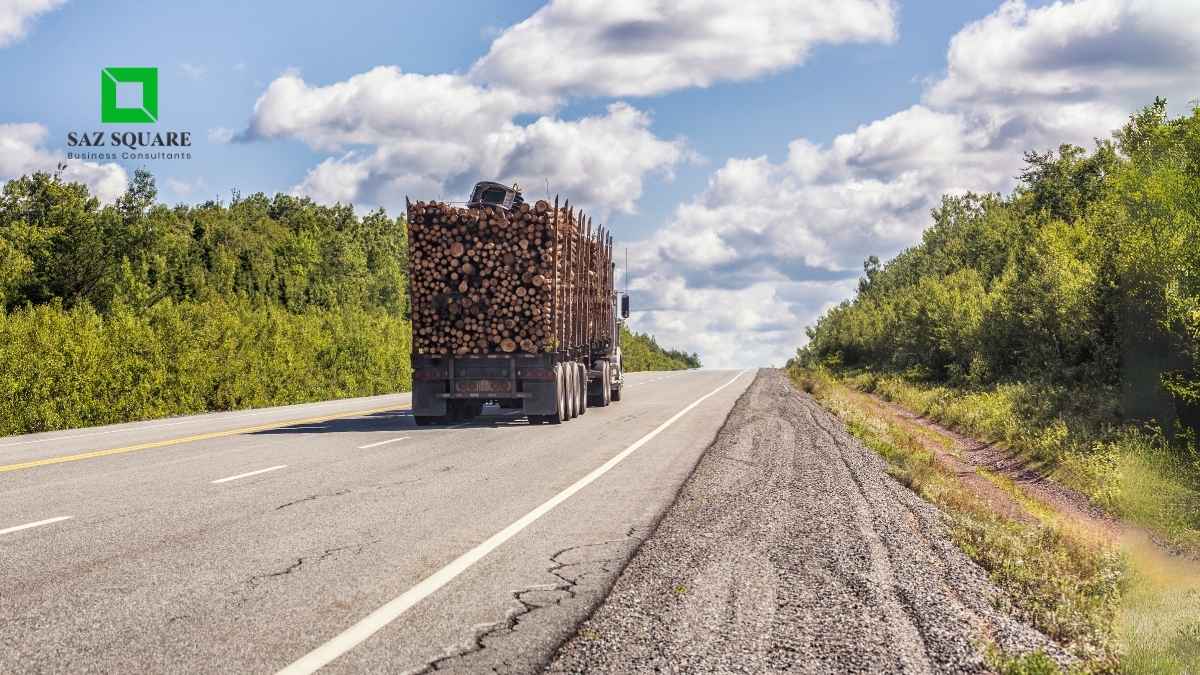Canada is home to vast forests, and with that comes an ongoing demand for logging trucks. The logging industry plays a vital role in the Canadian economy, and if you’re looking to tap into this thriving sector, this business is an excellent opportunity. Here’s everything you need to know about starting a logging truck business in Canada, from the initial planning stages to profitable operations. And with proper guidance from SAZ Square, ofc.
There will always be space for you in this market (odds favor) even if you’re an entrepreneur or just an experienced truck driver. However, starting a logging truck business isn’t as simple as just buying a truck and hitting the road.
Understanding the local regulations, securing proper licenses, and investing in the right equipment are just some of the key steps involved.
Why Start a Logging Truck Business?
Canada’s logging industry is a cornerstone of its economy, with British Columbia, Ontario, and Quebec being the main regions driving demand for timber transport. The logging truck business is profitable, especially with the increasing demand for wood products in global markets. Whether you’re transitioning from regular trucking or starting from scratch, there’s a significant opportunity in this market.
The ability to haul timber across Canada, with its forests spanning vast distances, presents a unique business model with lucrative returns. But, as rewarding as it can be, this industry also comes with its challenges that require a thorough understanding of regulations and operations.
Key Steps to Starting Your Logging Truck Business
A. Develop a Business Plan
- A well-crafted business plan is crucial for laying out your strategy. It should include your target market, financial projections, and a roadmap for growth.
- The plan must also account for logistics: where you’ll operate, the trucks you’ll need, and your pricing strategy.
For reliable projections, prepare your Notice to Reader financial statements early.
B. Secure the Necessary Licenses and Permits
Federal Licensing:
- National Safety Code (NSC): This applies to all commercial vehicles operating in Canada. It ensures your business meets safety standards.
- International Registration Plan (IRP): If you’re traveling between provinces or even the U.S., this plan helps register your vehicle for international travel.
- International Fuel Tax Agreement (IFTA): A fuel tax agreement you’ll need to maintain if crossing provincial borders.
Confirm whether you qualify as a factual resident of Canada before registering for cross‑border permits.
Provincial Licensing:
- British Columbia (BC) and Ontario have specific rules for logging trucks, including weight limits and seasonal road restrictions during spring thaw.

Understanding the Regulations
Canada’s logging truck industry is heavily regulated. The National Safety Code (NSC) ensures all commercial vehicles operate safely on roads. Apart from safety standards, there are specific guidelines for driving hours, log load securement, and weight limits.
In addition to federal regulations, logging truck operators must adhere to provincial rules. British Columbia, Alberta, and Ontario each have their own standards regarding road usage, driver certifications, and equipment. Also make sure to consult your province’s transportation authority for the latest rules, including compliance with Hours of Service (HOS), weight limits, and cargo securement.
Getting the Right Equipment
When it comes to logging trucks, the right equipment is essential. You’ll need a heavy-duty truck designed to withstand the rugged terrain of logging roads. Logging trucks typically have more powerful engines, heavier axles, and specialized suspensions to handle rough and uneven ground.
In addition to the truck, you’ll need logging trailers that can securely transport heavy loads of timber. The most common types are pole trailers and log trailers, each designed for specific needs. You may also consider investing in a self-loading truck, which includes a hydraulic loader for picking up logs directly from the logging site, offering greater flexibility in remote areas.
Cost Breakdown and Profitability
Starting a logging truck business involves significant initial costs. A new truck could cost between $100,000 and $200,000, and trailers can run another $50,000 to $100,000 depending on the type. Apart from the cost of the equipment, you’ll also need to factor in insurance, fuel, maintenance, and licenses. Given the high operational costs, it’s essential to have a clear financial plan to ensure profitability.
The good news is that the logging industry offers relatively high-paying contracts, often based on hourly rates, per ton, or per load. However, the profitability of your business will depend on various factors, including seasonal demand, fuel costs, and the maintenance of your trucks. Many operators find that once their business is established, they can generate stable and consistent revenue despite some seasonal fluctuations.
Talk to our taxation services team if you need help with GST/HST, IFTA, and year‑end filings.
Overcoming Challenges
Operating a logging truck business isn’t without its challenges. First, you must navigate harsh road conditions, including muddy, rocky, and snow-covered roads that require specialized driving skills. Maintenance can be costly, as logging trucks endure more wear and tear compared to regular freight trucks. You’ll need to ensure that your vehicles are regularly serviced to avoid breakdowns, which can be expensive and disrupt operations.
Additionally, regulatory compliance is a significant challenge. From weight limits to driver hours, there are many rules to follow, and penalties for non-compliance can be severe. As the business owner, it’s essential to stay up-to-date with regulations to avoid costly fines and ensure the safety of your team and equipment.
Transitioning from Regular Trucking to Logging Trucks
For truckers transitioning from general freight to logging trucks:
- Be prepared for different driving conditions: logging trucks operate on rural roads, often in remote areas.
- You’ll need to learn new skills, such as operating a self-loading truck and properly securing log loads.
- It’s advisable to undergo training specific to logging trucking, such as log-hauler training programs offered by organizations like the Interior Logging Association.
Marketing Your Logging Truck Business
Building a client base in the logging industry often depends on networking and reputation. Attend local forestry and logging events to meet potential clients. It’s also important to get your name out there through online platforms, industry-specific directories, and social media. Consider creating a website that highlights your services, certifications, and safety protocols to attract more customers.
Additionally, partnering with forestry contractors and sawmills can provide steady work. Many logging companies will subcontract their hauling needs, providing opportunities for smaller operators to get involved.
Scaling Your Business
Once your business is running smoothly:
- Expand your fleet by adding more trucks and hiring drivers.
- Take on larger contracts, and consider diversifying into other areas of transport (e.g., construction or equipment hauling) to maintain cash flow during the off-season.
Start Logging Truck Business in Canada Now
Starting a logging truck business in Canada can be highly rewarding, with the potential for high profits in a growing industry. However, it’s essential to plan carefully.
Understand the regulatory landscape and invest in the right equipment. Navigate the challenges, focus on safety, and build strong industry relationships.
Checking all these you can successfully enter and thrive in the logging truck business.
Gold luck. 🤑
FAQs
What’s the first step in starting a logging truck business in Canada?
The first step is to develop a business plan, register your company, and secure the necessary licenses and permits. You’ll also need to decide whether to operate locally or internationally, depending on your intended routes.
How much do logging trucks cost in Canada?
The cost of a logging truck can vary widely, with prices for a new truck ranging from $100,000 to $200,000, depending on the model and equipment. Used trucks can be significantly cheaper but may require more maintenance.
Can I transition from regular trucking to logging?
Yes, but it requires specialized training. You’ll need to learn how to drive in rugged conditions, operate self-loading trucks, and comply with the specific regulations for logging trucks. Start by gaining experience and training to ease the transition.



